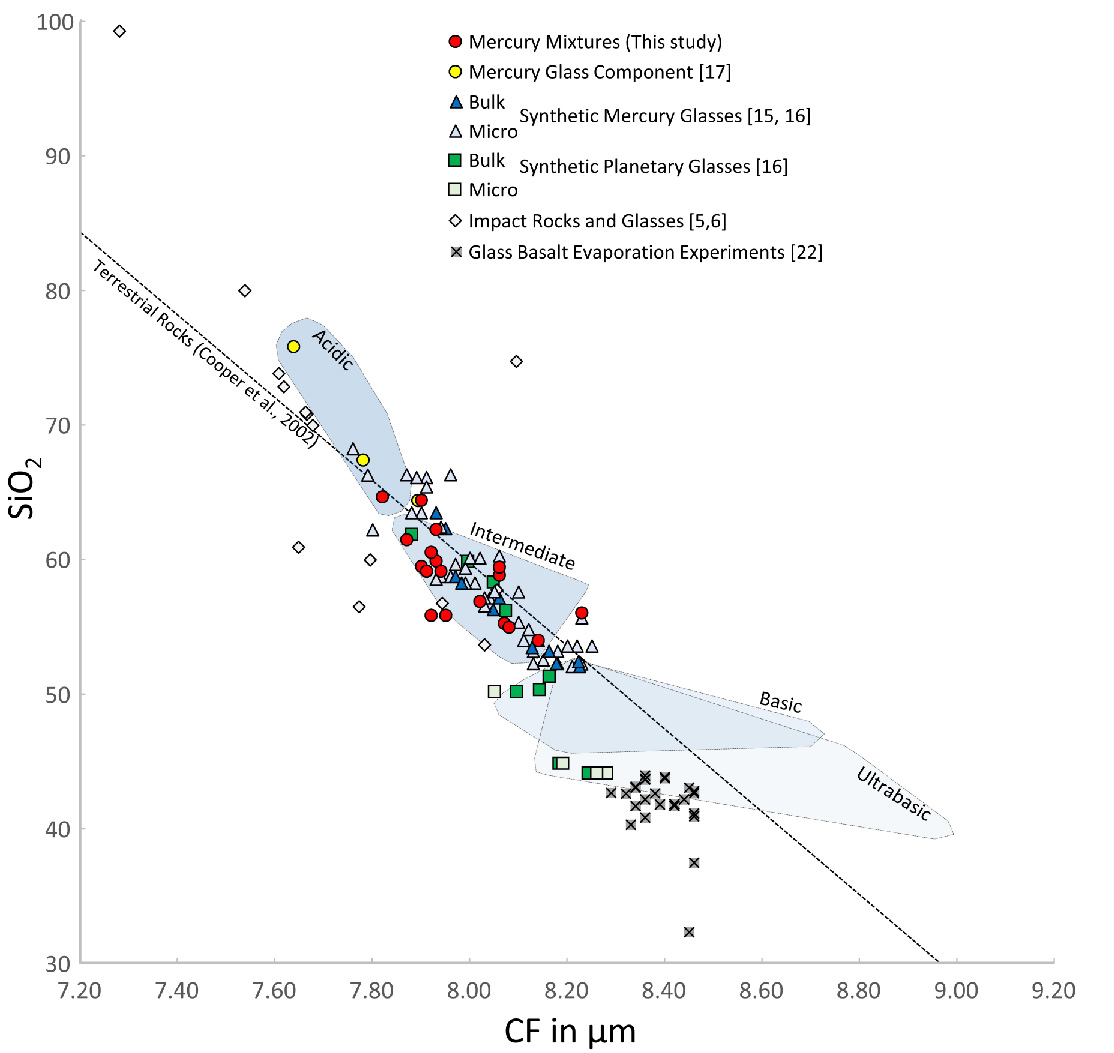Synthetic Analogs for Surface Regions on Mercury: A Mid-Infrared Study for the BepiColombo Mission
- 1Institut für Planetologie, Westfälische Wilhelms-Universität Universität Münster, Wilhelm-Klemm-Strasse 10, 48149, Germany
- 2Institut für Mineralogie, Westfälische Wilhelms-Universität Universität Münster, Corrensstrasse 24, 48149 Münster
- 3University of Liege, Department of Geology, 4000 Sart-Tilman, Belgium
- 4Department of Earth and Environmental Sciences, KU Leuven, 3001 Leuven, Belgium
- 5Institute for Planetary Research, DLR, Rutherfordstrasse 2, 12489 Berlin, Germany
Introduction: The IRIS (Infrared and Raman for Interplanetary Spectroscopy) laboratory generates mid-infrared spectra for the ESA/JAXA BepiColombo mission to Mercury. Onboard is a mid-infrared spectrometer (MERTIS-Mercury Radiometer and Thermal Infrared Spectrometer), which will allow to map the mineralogy in the 7-14 µm range [1, 2]. In order to interpret the future data, a database of laboratory spectra is assembled at the Institut für Planetologie in Münster (IRIS) and the DLR in Berlin.
So far, we have studied for this purpose natural mineral and rock samples (e.g. 3, 4), impact melt rocks (e.g. 5, 6, 7) and meteorites (e.g. 8, 9, 10, 11). Furthermore, surface processes like regolith formations and space weathering were of interest (e.g. 12, 13, 14).
Synthetic analogue materials have become one of the foci of our work, since they allow to produce ‘tailor-made’ materials based on remote sensing data and/or modelling and experiments. These are closer than natural terrestrial materials, which formed usually under different conditions as expected on Mercury [e.g. 1]. We synthesized analogs for surface regions of Mercury and other planetary bodies (15, 16, 17).
In this part of our study, we present mixtures based on phase equilibria of peridotite and partial melt compositions which were studied under hermean mantle conditions - temperature, pressure, oxygen fugacity (18,19,20). These experiments suggested that the crustal mineralogy should be dominated by variable abundances of plagioclase, olivine, clino- and orthopyroxene, with unconstrained proportions of silicate glass. Based on the model mineralogy of representative results, we produced mineral/glass mixtures based on the Low-Mg Northern Volcanic Plains (NVP)(Y121, Y131, Y172), High-Mg NVP (Y143, Y144), Smooth Plains (Y140, Y143, Y144), Inter crater Plain and Heavily Cratered Terrains (IcP-HCT) (Y126, Y131, Y132, Y146), and High-Mg Province (Y126, Y131, Y146) [20].
Samples and Techniques: We conducted diffuse reflectance studies of sieved size fractions (0-25 µm, 25-63 µm, 63-125 µm and 125-250 µm) under vacuum conditions, ambient heat, and variable geometries. We used a Bruker Vertex 70v with A513 variable geometry stage. The results will be made available in the IRIS Database [1].
Results: First results show the Christiansen Feature (CF), a characteristic, easy to identify reflectance low (or emission high) ranging from 7.9 µm to 8.2 µm (always average of all size fractions). The Transparency Feature (TF), typical for the finest size fraction (0-25 µm) is in many mineral mixtures less pronounced than for pure mineral phases. Here the individual TF of the components result in a broad feature.
The resulting spectra can be divided into three groups – such as dominated by a single glass feature at 9.6 – 9.9 µm, a second groups with forsterite bands 9.4 µm- 9.5 µm, 10.2 µm, 10.6 µm, 11.9 µm and 15.9 µm-16 µm, and a third dominated by pyroxene bands at 8.9-9.1 µm, 9.4-9.5 µm, 9.9 µm, 10.2 µm, 10.4-10.5 µm, 10.6 µm, 10.8-11 µm 11.1-11.3 µm and 11.4-11.6 µm. Plagioclase features, even when the phase is dominating the composition, are usually ‘overprinted’ by forsterite and pyroxene bands.
Discussion: A classic way to connect an easy to identify spectral feature in the mid-infrared to the chemical bulk composition is using the CF and the SiO2 content. Both show a strong correlation for both terrestrial rocks [21] and a variety of synthetic analogue samples from earlier studies in this project [15, 16, 17] (Fig.1).
Summary & Conclusion: In a next step, we will study these mixtures under more realistic conditions, i.e., high vacuum and high temperature, in order to better simulate the hermean surface. Also, these mixtures will be used to test spectral unmixing routines, which allow to identify abundances of single minerals in a complex mixture of phases.
References: [1] Hiesinger et al. (2020) Space Sci. rev. 216, 110 [2] Benkhoff et al. (2022) Space Sci. Rev. 217, 90 [3] Reitze et al.(2020) Min. Pet. 114, 453-463 [4] Reitze et al.(2021) EPSL 554, 116697 [5] Morlok et al.(2016) Icarus 264, 352-368 [6] Morlok et al.(2016) Icarus 278, 162-179 [7] Reitze et al.(2021) JGR (Planets) 126, e06832 [8] Weber et al. (2016) MAPS 51, 3-30 [9] Morlok et al. (2017) Icarus 284, 431-442 [10] Morlok et al. (2020) MAPS 55, 2080-2096 [11] Martin et al. (2017) MAPS 52, 1103-1124 [12] Weber et al. (2020) EPSL 530, 115884 [13] Weber et al. (2021) EPSL 569, 117072 [14] Stojic et al. (2021) Icarus 357, 114162 [15] Morlok et al. (2017) Icarus 296, 123-138 [16] Morlok et al. (2019) Icarus 324, 86-103 [17] Morlok et al. (2021) Icarus 361, 114363 [18] Charlier et al. (2013) EPSL 363, 50-60 [19] Namur et al. (2016) EPSL 439, 117-128 [20] Namur and Charlier (2017) Nature Geosci. 10, 9-13 [21] Cooper at al. (2002) JGR 107, 5017-5034 [22] Morlok et al. (2020) Icarus 335, 113410

Figure 1: Comparison of the Christiansen Feature (CF), a characteristic reflectance low, to the SiO2 bulk composition. The results from this study (red circles) fall along the regression line for terrestrial intermediate rocks.
How to cite: Morlok, A., Renggli, C., Charlier, B., Namur, O., Klemme, S., Reitze, M., Weber, I., Stojic, A. N., Bauch, K., Schmedemann, N., Pasckert, J.-H., Hiesinger, H., and Helbert, J.: Synthetic Analogs for Surface Regions on Mercury: A Mid-Infrared Study for the BepiColombo Mission, Europlanet Science Congress 2022, Granada, Spain, 18–23 Sep 2022, EPSC2022-876, https://doi.org/10.5194/epsc2022-876, 2022.

